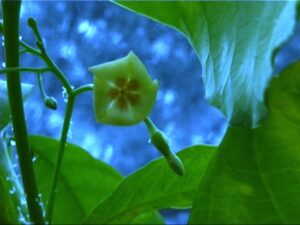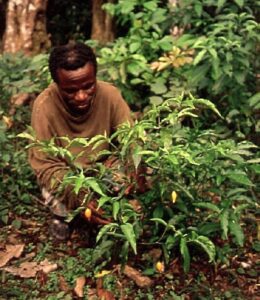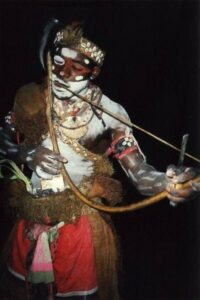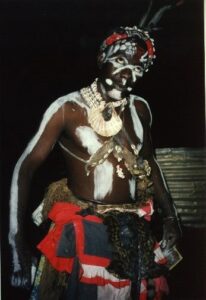Iboga Plant
Most people who have heard of ibogaine and iboga treatment for addiction are aware that it comes from a plant from Africa, and that its original use is a part of the spiritual practice of people of somewhere on that continent. However, to truly understand ibogaine, the plants it comes from – plants in the Apocynaceae family, most specifically Tabernanthe iboga – and its applications, one must delve into the history of the Bwiti religion, and the uses of this plant within it. Although Bwiti is a relatively new religion from a historical context, it is syncretistic, and merges traditional African spiritual beliefs and practices with the beliefs and practices of Catholicism. So, despite the emergence and rapid growth of Bwiti over the past century, it is drawn from two very old religious cultures; although the merging of the two is new, both of its foundations have existed separately for many centuries before joining together in this new faith.

Bwiti’s Beginnings
Bwiti Beliefs
Bwiti is a fascinating belief system that incorporates animism, ancestor worship, and Christianity into one cohesive religion with a little bit of everything. Although the name Bwiti easily translates into “dead” or “ancestor” in Niger-Congo Bantu languages, more recent investigation into its etymology suggests that the name of this religion more likely comes from the proper name of a group of pygmies, the Mbouiti, who still live in the jungle on the border of Gabon and Zaire today.
People who practice Bwiti generally consider themselves Christians, and their stories and mythology includes many references to the bible and often mirror commonly known biblical tales. In fact, many practitioners believe that Gabon has a connection with the location of the biblical Garden of Eden, and that the iboga tree is a descendent of the Tree of Knowledge described in the Book of Genesis. Each community gets together for a meeting similar to mass on Saturday evenings (that lasts until Sunday morning), and their biggest holidays are Christmas and Easter. They hold initiation rites and some of their rituals are reflective of Catholic sacraments. However, they do not believe in Hell, and so far, there is no written text specific to Bwiti, likely due to the great variances between different sects. It’s likely that a text of some sort will emerge, though, as Bwiti continues to grow.
Bwiti is monotheistic, with one God that is commonly referred to as Nazame Mebeghe; he is similar to the god worshipped in Catholicism, but is less angry and vengeful, and usually does not seek to punish his followers. According to Bwiti mythology, he created the world, and an egg, from which triplets were born. These triplets, Eyene, None, and Gningone basically correspond to the Catholic trinity of the Father, the Son, and the Holy Ghost, but the final triplet of the three, Gningone, has a feminine energy that could perhaps be more easily compared to the Virgin Mary. Bwiti followers view Gningone as the mother of the black race.
Bwiti Today
Today, Bwiti has begun to spread far and wide and it is unknown how many people practice it currently. It has spread into the countries near and adjacent to Gabon, such as Cameroon, The Republic of the Congo, Zaire, and Equatorial Guiniea, although it is practiced in secret in the latter of these due to religious persecution there by Christian missionaries even today. In most of these places though, it is accepted and widespread, and generally, it is open to all. Practitioners feel that Bwiti is for anyone who approaches it with respect, regardless of race or background. Many followers hope that it will someday be will known around the world, and that it will take root in western countries to the same extent that Christianity has over the past few centuries in Africa.
In Gabon, as mentioned above, Bwiti is one of the three official recognized religions in that country. In 1960, the country’s first president, Leon M’ba, was a practitioner and had experienced iboga initiation. During the transition from French colony to independent country, he vocally defended iboga in French colonial courts. Further, in 2000, the Council of Ministers of Gabon declared iboga a national treasure. Bwiti is viewed as a popular religion that keeps alive the tribal values that are an important part of the spirit of the country. Many government leaders, as well as police, army, and government officials, are iboga initiates and openly participate in weekly ceremonies on Saturday nights. Today, Bwiti is as common in Gabon’s capital, Libreville, as it is more rural areas.
Bwiti & Iboga

Use of the iboga plant is a vital and integral part of the Bwiti religion. The roots of this plant are cultivated and harvested specifically for spiritual growth. The goals of its use are numerous; religious leaders encourage its consumption first and foremost for the radical spiritual growth of the individual, but also its ingestion aims to help stabilize family and community structure, to heal illnesses, and to help resolve personal, pathological problems of the person. Further, it is used in traditional rite of passage ceremonies, and in religious meetings by the community collectively. Large doses yield complex visions and deep introspection that is viewed as beneficial to not only the individual consuming iboga, but an individual’s participation is also seen as beneficial to the larger community as a whole.A spiritual leader called N’ganga leads the frequent ceremonies that involve iboga therapy. The root word of this term, gang, relates to wisdom, knowledge, and skill in Bantu languages. Ceremonies of all kinds begin at night and in many cases last several days. During that time, participants consume the root of the iboga plant in tea, or more commonly, the root scrapings directly. A traditional torch of bark and tree sap is burned, and drums and the traditional Ngombi harp are played. Choreographed traditional dances accompany the ceremonies and a single dance can last an hour or more without a rest. The most important ceremony is the rite of passage/initiation ceremony, but ceremonies in general are frequent. For example, a weekly ceremony akin to Catholic mass occurs on Saturday nights, and other ceremonies pay homage to ancestors, aim to heal the sick or drive out bad spirits, or are held in celebration of major holidays like Easter and Christmas.
Initiation Rites/Rite of Passage
The initiation ceremony, or rite of passage, is the most important ceremony in the Bwiti religion. It’s similar to what a drug dependent individual might experience at an iboga wellness center when their addiction is lifted from them. It’s not mandatory that all Bwiti practitioners participate in one of these ceremonies, but most do choose to be initiated for personal reasons, ranging from coming of age, to health issues, to other support for traumatic events. Participation in one of these ceremonies can be undertaken at any age, and in some sects, the first experience with it can occur at ages as young as eight to ten; in these cases, the individual will likely participate in another rite of passage early in adulthood as well.Prior to ingestion of iboga root bark, the initiate will make an offering to the jungle, will take a ritual bath, and will make a confession in front of officiating members. The confession covers all of their missteps in life up until that point, and it is important that they include everything. Omission of sins can lead to disastrous results for the initiate, it is warned, and could even cause permanent madness or even death.
After bathing and confession, the individual is dressed in red, black, and white cloth. Initiates, as well as other participants there to assist, usually wear raffia skirts, shells or beads, and animal skins. When the ceremony begins in the evening, a large quantity of iboga root bark is ingested, and over the next seven to twelve hours, the person being initiated will eat as much as several hundred grams of it.
Once under the influence of iboga, the initiate will lie on the floor much of the time, surrounded by the other participants. He or she will be assisted by the “father” and “mother” assigned to help during the ceremony, along with other members of the community. These helpers will likely ingest smaller amounts of the iboga root during the ceremony as well. Over time, the initiate’s consciousness will change throughout and visions will become more intense as they become more and more separated from reality. At some point, usually during the third night, an officiating member will use a thorn pressed into the initiate’s skin to see if there is a reaction; if not, then the individual is determined to be completely separated from the exterior world, and is experiencing the climax of the ceremony. The hallucinations and visions are at their peak then, and Bwitists view this as the moment of true baptism and direct dialogue with God.
Over time, the initiate will eventually come back to reality and into what is believed to be and is seen as a new life. After the iboga experience is over, the participant will recount his or her journey and visions to the greater community. Some report going to the afterlife and speaking with the divine, either alone or with the help of ancestors. Many have encounters with religious figures like the Virgin Mary, Jesus, or St. Peter. Others experience profound symbolism including animals, plants, the jungle, or other things that are important to them in their own personal history.
All in all, the initiation ceremony is considered an experience of great illumination and is something that will stay with the participant throughout the rest of his or her life. A new name is revealed to him or her during the iboga experience, and it is added to the given name from that point forward. Furthermore, this initiation ceremony is something the individual will return to mentally and emotionally during all times of struggle, thereby putting himself or herself at the best point for observation of the situation at hand. It’s truly a life changing experience in every sense of the phrase, and cannot fully be understood by people who have not been through it themselves. “One must see to believe” is a common proverb across all Bwiti sects, in many ways in reference to this particular experience.
Night Ceremonies (Ngoze)

This all begins at about 8 p.m., and what soon follows is collective religious fervor and joy. It is a time for loving one another, and for much celebration. People dress in white, blue, or yellow depending on their sect, and paint their faces with white kaolin. Throughout the night they sing, dance, and chant. Often, alcohol is consumed to keep them active and energetic, despite alcohol being otherwise frowned upon among Bwitists.
There are two distinct parts to these night ceremonies. In the first, which generally lasts from sundown to midnight, the songs, chants, dances, and symbolism mainly focus on the beginning of the world, the creation of Adam, and the birth of Christ. In the second part, which continues from midnight onward to dawn, the focus shifts to death and destruction, expulsion from the Garden of Eden, the universal flood, and the death of Christ. As dawn approaches, though, the group moves into the most emotional portion, known as nlem myore Nlem myore can be translated as “one heart only,” and it is at this point during which the community feels an exceptional feeling of oneness, and tears of joy are shed by all.
As the sun rises, the group gathers for a collective meal in celebration. Although this occurs weekly in most sects, some also choose to have a multi-day ngoze ceremony once a month or once every two or three months that can last several days. And, during Christmas and Easter, the two most important holidays for Bwitists, these ceremonies generally continue for four days or longer.
The Bwiti religion and its partnership with iboga is fascinating. Practitioners and believers are very religious people who are often very involved not only in the tenets of the religion itself, but also in the importance of community overall. The experience with iboga helps to connect these people on a level that is likely difficult for outsiders to even understand or fathom. Further, the combination of Christianity and traditional African spiritual practices seems to be exactly what many Bwiti practitioners for the few generations it has existed seek. The Gabonese have certainly embraced it heavily, and it will be interesting to see how it disseminates and grows over the decades and centuries ahead. Perhaps it will, as some current followers hope, advance and spread prolifically throughout the world as a whole, giving others worldwide the opportunity to feel a direct connection with God and others in their community through the iboga experience and ceremonies as well.
Iboga Root and Ibogaine
The use of iboga root has increased significantly over the years. It is still used in ritual and spiritual ceremonies in various African cultures. Tabernathe iboga has also been incorporated into medicines used to treat fever, high blood pressure, influenza, and other health disorders. It has even been used as part of a revolutionary addiction treatment – ibogaine therapy.
Ibogaine is a naturally occurring psychoactive indole alkaloid derived from Tabernathe iboga. It is used in some African cultures to treat fatigue, thirst, and hunger, among other health issues. Additionally, ibogaine – like iboga root bark and iboga seeds – is sometimes used in spiritual initiation ceremonies.
Research indicates ibogaine helps alleviate drug cravings and withdrawal symptoms, too. In fact, several peer-reviewed medical journals indicated ibogaine therapy helps reduce addiction symptoms, including those associated with cocaine, heroin, methamphetamines, and opiates.
Iboga for Addiction Treatment
Ibogaine therapy provides an addiction treatment unlike any other. It quickly brings a person back to a pre-addicted state and limits his or her risk of future drug cravings. Plus, Ibogaine has been shown to eliminate up to 95% of withdrawal symptoms associated with opioid withdrawal.
During ibogaine therapy, ibogaine puts a person in a dreamlike state. At this point, a person may experience a series of scenes, dreams, and other visions. Meanwhile, a person’s drug withdrawal symptoms recede and dissipate within about 30 to 45 minutes of ingesting ibogaine. This helps reset a person’s body to its pre-addicted state.
Next, a person enters the “processing” phase of ibogaine therapy. The processing phase enables a person to reevaluate his or her addictive behaviors from a new vantage point. It also allows a person to identify the root cause of his or her addiction, as well as process his or her feelings accordingly.
Ibogaine for addiction treatment is an intense experience. It provides unparalleled insights into a person’s subconscious and allows an individual to take a fresh look at his or her addiction. With these insights, an individual then can embark on a journey toward an addiction-free life.
Iboga Success Rate
Research shows iboga can help individuals overcome their addictions. However, the success of ibogaine therapy often varies based on the individual and his or her aftercare program.
Ibogaine for addiction treatment alone is insufficient. Instead, an individual must have a long-term plan in place to treat his or her addiction. Thanks to an ibogaine therapy aftercare plan, an individual is better equipped than ever before to combat his or her drug cravings and prevent a relapse.
Each aftercare plan is crafted specifically for an ibogaine therapy patient. It ensures a patient is prepared for life after ibogaine therapy and understands the challenges he or she may face in the future.
Also, an aftercare plan offers an ibogaine therapy patient the support he or she needs to permanently overcome an addiction. It helps an ibogaine therapy patient take control of his or her life, and ultimately, understand exactly what it takes to manage his or her addictive behaviors.
To find out more about iboga for addiction treatment, please contact Transcend Clinic today at 760 621 6203.
Articles About Iboga and Ibogaine
For more information about the iboga plant, refer to these articles:
Beware of Ibogaine For Sale! Where to Get Ibogaine
This article details the dangers of trying to buy and use ibogaine or the iboga plant without expert supervision. Today, there are many “fly by night” sources for what is alleged to be ibogaine or the iboga plant online, but it’s not safe to try to attain ibogaine from these sources. Even if what you get online is actually the iboga plant, using it on your own carries a number of risks with it, which this article describes. For the straight story on where to get ibogaine—and where to avoid getting it—see this article.
Why Iboga Treatment Gets a Bad Reputation
This post dives into the topic of how disreputable iboga treatment centers operate, and how their lack of expertise and care causes iboga treatment more generally to endure a bad reputation. In reality, though, there are major differences between iboga treatment centers and how they operate; this post explains those differences so consumers can make informed choices about their ibogaine treatment options. It also differentiates between providers who are using ibogaine as a marketing tool and the way real iboga treatment clinics use iboga, as a powerful therapeutic tool.
Iboga Sustainability and Using cGMP Ibogaine
This article outlines the current world-wide situation with over-harvesting and poaching of ibogaine derived from tabernanthe Iboga in Gabon. Due to the rise of ibogaine treatment “clinics” worldwide, there is an extensive shortage of ibogaine. It is important to understand the origins of the ibogaine you are using, and whether it comes from a lab that adheres to Good Manufacturing Practices, and is intended for human use, vs. bathtub chemistry and poaching, formulating by people who obtain illicit ibogaine supplies and then follow “cookbook” examples of how to produce ibogaine hydrochloride, with little understanding of what they’re actually doing, resulting in an unsustainable and potentially dangerous end product (which YOU are going to wind up ingesting).
Iboga For Addiction: Does it Really Work?
This piece takes on the question of whether iboga for addiction really works. It provides a detailed look into the history of both the drug war in the United States and the evolution of iboga treatment, both here in the US and abroad. The post then takes on some of the persistent myths about iboga treatment and offers factual corrections for them. It also connects developments in the drug war with changes in drug and addiction treatment policies, and provides insights into why iboga, although a highly effective addiction treatment, is often badmouthed in the industry.
Is Iboga Treatment a Scam?
This post takes on the notion that iboga treatment for addiction is a scam. It explains that while there are certainly a number of “scammy” iboga treatments available, especially online, iboga absolutely works—for the right goals. Iboga provides a type of interruption therapy, breaking the cycle of addiction long enough to allow the brain to reset and the person coping with addiction to implement a recovery plan. However, people who claim that iboga treatment is an instant, 100% effective cure all for addiction are probably scammers.
Breaking the Cycle of Addiction With Iboga
This piece describes the history of how the iboga plant was first used and discovered, and how it came to Europe and the US over time. It also details just how it is that the iboga plant interacts with the brain, and how iboga treatment can interrupt the cycle of addiction and reset the brain. This post also provides some details about the research conducted by the Transcend Clinic team, and how our unique approach works in practice.
